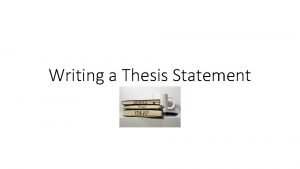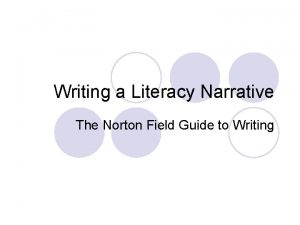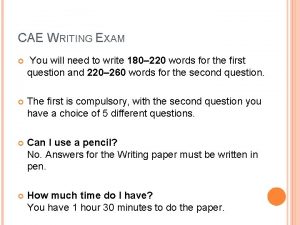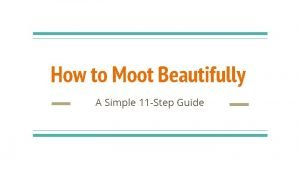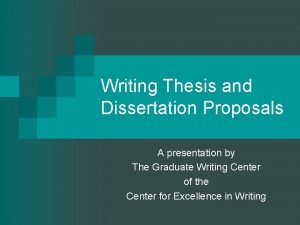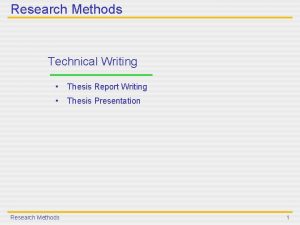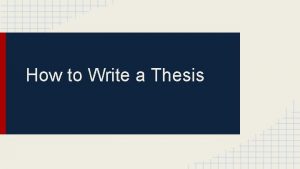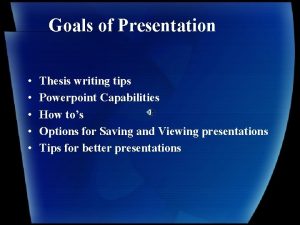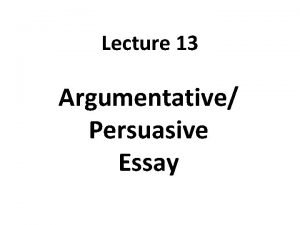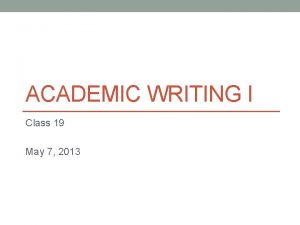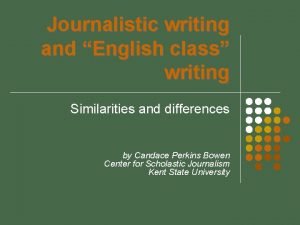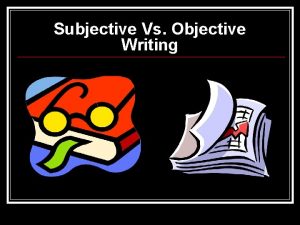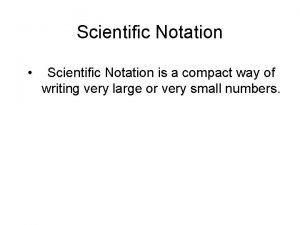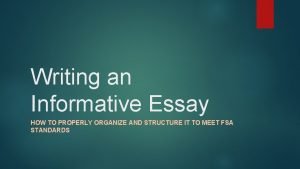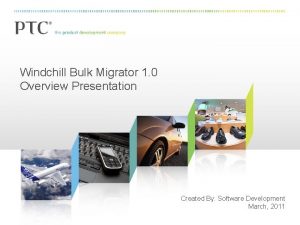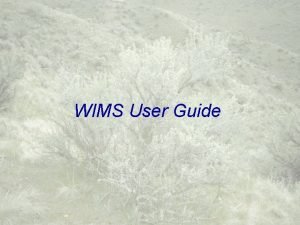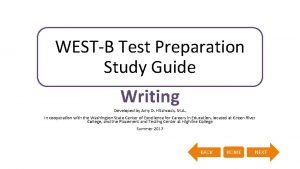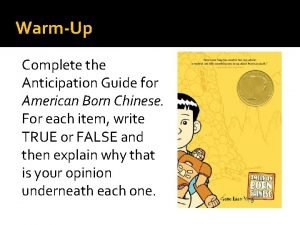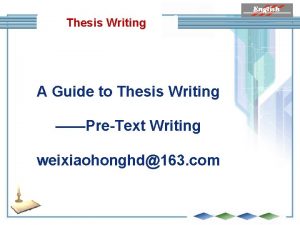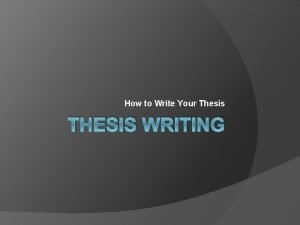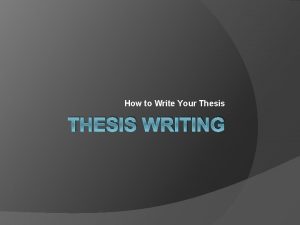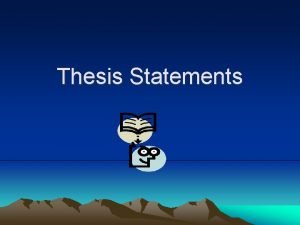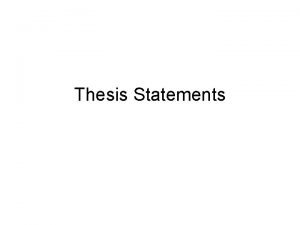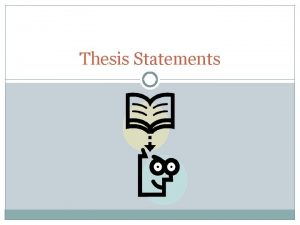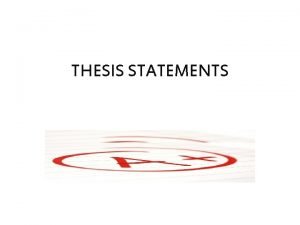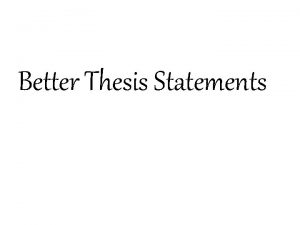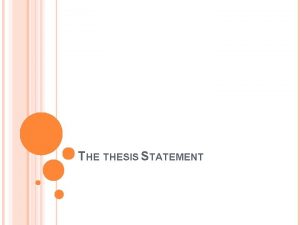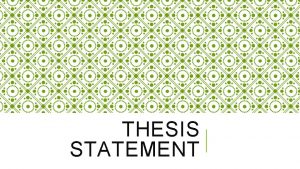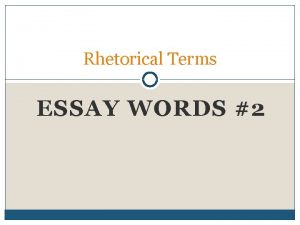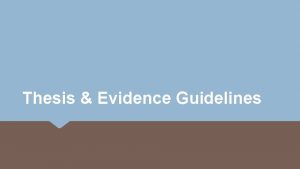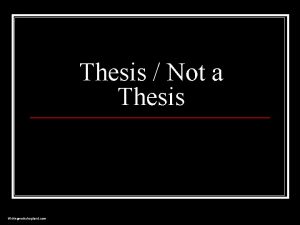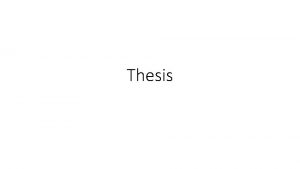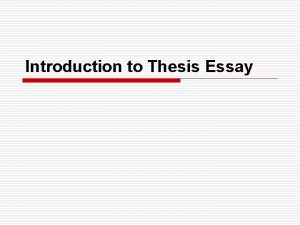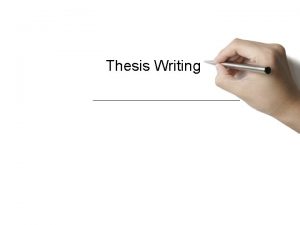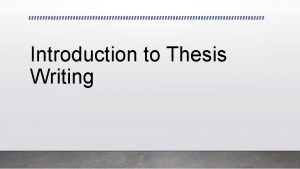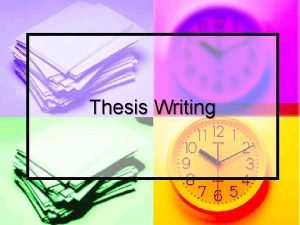Thesis Writing A Guide to Thesis Writing Writing





































- Slides: 37


Thesis Writing A Guide to Thesis Writing —— Writing the First Draft weixiaohonghd@163. com

Draft Writing First Draft 1. Suggestions 3. Language 2. Style 4. Mechanics

Suggestions 写作建议 1) Making a Plan (制定写作计划): 2) Each time focus on one chapter or part. 3) Finish thesis step by step. Writing the first draft

Suggestions 写作建议 2)Following the Process of Writing(遵循写作规律): 1. (1) Brain-storming: 2. writing down whatever comes into your mind (2) Mind-mapping: organizing ideas expanding paragraphs Writing the first draft

Suggestions 写作建议 (3) Consultation: getting inspiration to enrich your ideas from references or a focused purposeful discussion. (4) Idea-noting: Taking down the new ideas Writing the first draft

Suggestions 写作建议 3) The first draft is not the final draft. You may write many before you finish your final one. Writing the first draft

Suggestions Attentions: 1) the organization and development of your ideas; 2) the unity and coherence of your presentation; 3) the command of sentence structure, grammar, and diction 4) capitalization, spelling, punctuation, etc.

Writing the First Draft Writing Style Language Focus Mechanics 返回

Writing Style § 1) Usually, write in the third person § In this thesis I want to discuss… § √ The present thesis attempts to discuss… § Now I want to conclude that… § √ It is concluded that…

Writing Style § 2) Write straightforwardly § The style should be neither artificially formal nor as loose and relaxed as a personal letter. § Writers don’t usually… § √ Writers do not usually…

Writing Style § 3) Always refer to individuals by their full name (given and surnames) or by surname alone. § √ Steinem says… or Gloria Steinem § ——not “Gloria says…” § √ Dr. Jane Smith, President Truman, Dame Sutherland…

Writing Style 4) Write as specifically as possible § Everyone in China is learning English. § √ Many people in China are learning English. § Young √ five years old § Strive to say exactly what you mean and never let the reader guess at your intention.

Writing Style § 5) Show no bias toward a person’s age, sex, race, political attitude, religious beliefs, sexual orientation, or national origin unless such information is necessary to what you are writing (or appears in a passage you quote). § Fairness should be evident in your own writing. § But you cannot change what other people have written or said.

Writing Style § No longer use he , him or his; she, her § e. g. § “If a young artist is not confident, he can quickly become discouraged. ” § — “If young artists are not confident, they can quickly become discouraged. ” § — “A young artist who is not confident can quickly become discouraged. ”

Writing Style 写作风格 Try to use carefully the direct quotations You should quote no more than 30% of your thesis. Requirements for Style 返回

Language Focus Tense Choice Unity Coherence 返回

Tense Choice § 1) Past tense: reference to single studies § e. g. § Jones (1987) investigated the causes of illiteracy. § The causes of illiteracy were investigated by Jones (1987).

Tense Choice § 2) Present tense: reference to areas of § § inquiry探究、�� e. g. The causes of illiteracy have been widely investigated (Jones 1987, Ferrara 1990, Hyon 1994). There have been several investigations into the causes of illiteracy (Jones 1987, Ferrara 1990, Hyon 1994). Several researchers have studies the causes of illiteracy (Jones 1987, Ferrara 1990, Hyon 1994).

Tense Choice § 3) Present: reference to state of current knowledge § e. g. § The causes of illiteracy are complex (Jones 1987, Ferrara 1990, Hyon 1994). § Illiteracy appears to have a complex set of causes (Jones 1987, Ferrara 1990, Hyon 1994). 返回

1) Unity § Maintain the order and continuity not only for the chapters or sections but for thesis as a whole, presenting ideas, observations or generalizations in a logical and consistent sequence. § A unified paper is one that deals with a single subject and a single idea. 返回

2) Coherence 连贯 A coherent writing should (1) hang together well, (2) hold the attention of readers, (3) help them move from one point to another. Requirements for Coherence

2) Coherence 连贯 Methods: (1) Transitional words and phrases (2) Pronouns (such as “he, she, they, them, those”) (3) Repetition of key words and phrases Requirements for Coherence

2) Coherence 连贯 (4) Consistent point of view It is better for you to make thesis statement clear at the beginning of your thesis, develop and support it in thesis and repeat it at the end of your thesis. Requirements for Coherence

2) Coherence 连贯 (5) Integration (Combination) of information You need skillfully integrate them with your own text and not just string together a series of quotations and paraphrases. Do not over quote. Avoid patchwork. Do not change your source. Requirements for Coherence 返回

Mechanics Numbers Abbreviations Italics and Titles 返回

1) Numbers § (1) seventy-five, three thousand— —should be spelled out. § (2) Use numerals for dates, page, street, serial, and telephone numbers.

1) Numbers § (3) A sentence should not begin with a numeral. § If a number must begin a sentence, spell it out, but whenever possible, rewrite the sentence. § e. g. Five hundred and seventeen people visited the gallery last week. § Revised: Last week, 517 people visited the gallery. 返回

2) Abbreviations § Avoid abbreviations in the text of a research paper. § Exceptions: § (1) Social titles: § Mr. Ms

2) Abbreviations (2) Professional and honorary titles: Dr. Prof. (3) Names of countries and organizations: U. S. A. UN… (4) Abbreviations accepted as words: SARS, AIDS… 返回

3) Italics may be used to provide emphasis, to refer words as words, to serve to indicate the correct reading of a word when it might be misunderstood. The use of italics should be kept to a minimum.

4) Titles of works (1) Titles in italics § Book, pamphlet, journal, newspaper, play, long poem, magazine, film, name of vehicle.

4) Titles of works (2) Titles in quotation marks § Article in a journal, magazine, newspaper, encyclopedia, compilation; § short story; short poem; § chapter in a book; § lecture and unpublished thesis.

4) Titles of works § (3) Capitalization § the first and the last words in titles, § the first word after a colon 返回

Draft Writing First Draft 1. Suggestions 3. Language 2. Style 4. Mechanics

Assignments § Write your first draft, giving a careful consideration to what we have discussed. Writing makes a n exact man.

The End Thanks for your attention. Goodbye.
 Closed thesis statement
Closed thesis statement Marking scheme for letter writing
Marking scheme for letter writing What are the key features of a literacy narrative
What are the key features of a literacy narrative Letter structure cae
Letter structure cae How to write an leq apush
How to write an leq apush 11step guide writing
11step guide writing Writing thesis and dissertation proposals
Writing thesis and dissertation proposals Technical writing thesis
Technical writing thesis Socialism thesis statement
Socialism thesis statement Hook bridge thesis
Hook bridge thesis Writing a thesis statement powerpoint
Writing a thesis statement powerpoint Should i write in first or third person quiz
Should i write in first or third person quiz Persuasive summary
Persuasive summary Tone formal and informal
Tone formal and informal Difference between formal and informal tone
Difference between formal and informal tone Technical and academic writing
Technical and academic writing Argumentative essay vs persuasive
Argumentative essay vs persuasive Business writing vs academic writing
Business writing vs academic writing What is the similarities of literature and journalism
What is the similarities of literature and journalism Examples of active voice
Examples of active voice Subjective vs objective writing
Subjective vs objective writing What is scientific notation
What is scientific notation How to do informative essay
How to do informative essay World geography spring final review
World geography spring final review Words their way spelling test template
Words their way spelling test template Sperry
Sperry Windermere high school electives
Windermere high school electives Windchill bulk migrator installation and usage guide
Windchill bulk migrator installation and usage guide Wims nap
Wims nap West b writing practice test
West b writing practice test Welcome message for tourist
Welcome message for tourist Waukee powerschool
Waukee powerschool Ja biztown citizen guide answer key
Ja biztown citizen guide answer key Ja biztown mayor speech ideas
Ja biztown mayor speech ideas Local guide program
Local guide program My home district is kishoreganj
My home district is kishoreganj Ways with words pdf
Ways with words pdf American born chinese book trailer
American born chinese book trailer
